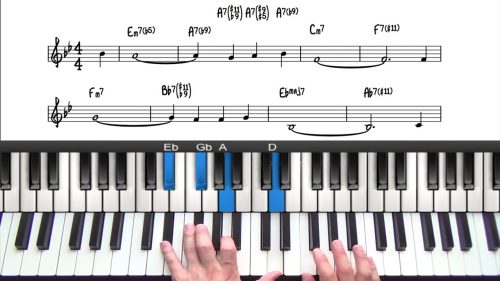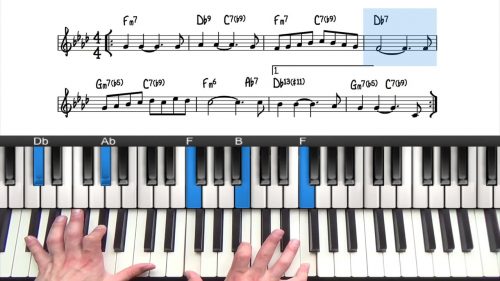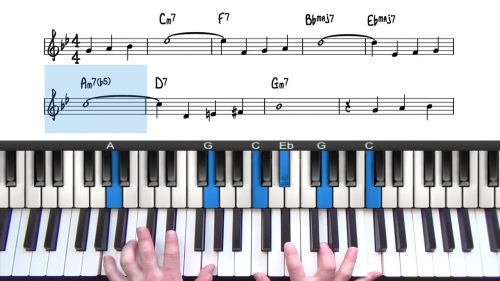UST Drills Over Minor 251s
Welcome to slot 6 in this practice series on altered harmony. We use this final slot to drill around minor 251 voicings with the b9#11 and the #5#9 upper structures.
We start by applying these upper structures in context of a few jazz standards so that we can see the end result of working on these exercises. We use the tunes “Autumn Leaves", “Stella By Starlight”, and “You Don’t Know What Love Is”.
b9#11 Minor 251 Drill
For the first drill we play minor 251 voicings similar to the example in “Autumn Leaves” and take it around all 12 minor keys.
We explore the minor 69 sound for the 1 chord and use this as our point of resolution.
Rootless #5#9 Minor 251 Drill
We then explore the #5#9 upper structure and apply to all 12 minor 251 progressions. Using the ii-11b5 voicing we move all the notes up by a minor 3rd interval to get a rootless #5#9 voicing over the V7 chord.
Being able to play and visualise these rootless variations is useful as we demonstrated in the tune “You Don’t Know What Love Is”.
The Connection To The Altered Mode
If we take a closer look at the notes in these 2 upper structures, they encompass all of the alterations over C7. If we add the major 3rd we then have the C altered mode and we can create interesting sounds by combining these upper structures over minor harmony.
For the final drill we combine both the #5#9 and the b9#11 upper structure triads. We alternate the inversions and resolve into the i-69 chord.
Lesson Downloads
-
Altered Harmony Practice Planner File Type: pdf
Practice Tips
-
Download the upper structure triad cheat sheet and keep it close to the piano for quick and easy reference.
-
Start the drills in different places on the circle of fifths to ensure that you are evenly distributing your practice time throughout all 12 keys.
-
For each upper structure voicing, make a conscious analysis of the scale degrees. In particular identify the altered tones in relation to the root note.
- Experiment with these upper structure triads over your favourite jazz standards.








Thank you for some wonderful exercises and I look forward to using them in the jazz standards. For the minor 6/9 chord, I noticed that the sixth note is natural whereas in the aeolian mode or harmonic minor it would be flattened. Is this because you are using the melodic minor mode?
Thank you for some wonderful exercises and I look forward to using them in the jazz standards. For the minor 6/9 chord, I noticed that the sixth note is natural whereas in the aeolian mode or harmonic minor it would be flattened. Is this because you are using the melodic minor mode?
Hi Charles 👋🏻
Good question!
I’ll quickly explain the different options we have in minor 251s, and then I will answer your specific question.
When we resolve to the 1 chord in a minor 251 we have the following options:
– i-7
– i-maj7
– i-6 and i-69
If you try resolving to each one, you will hear that they each have a slightly different character:
– The i-69 chord has the strongest sense of resolution. It has a rich and slightly dissonant character which I love about it. We find this voicing frequently in Bossa Nova and Samba styles, check out any of Jovino’s jazz standard lessons here and you will see it often appears in the minor 251s: pianogroove.com/bossa-nova-lessons/brazilian-grooves-course/
– The i-7 chord has a lesser sense of resolution than the i-69, as it sounds like it could lead somewhere else. For example it could be used as the ii-7 chord in a major 251 progression. This can be a nice choice of voicing if the harmony is moving elsewhere.
– Finally the i-maj7 has a resolved but slightly mysterious character and I like to use this for the final 251 in a tune as it creates an interesting colour to end on.
Play around with these so that you have an appreciation for the sound and colour that each one creates.
Finally to get to your question:
The -69 chord could imply either the melodic minor, or the dorian mode, as both of these scales contain the natural 6th. We could choose one of these scales as a pool of notes to develop our melodic ideas in our right hand, and that would establish which scale we are using, as it is not firmly established just from the presence of the b3, 6, and 9, in the chord.
Here’s a viewpoint that helps me with minor scale theory:
I like to think of natural minor, harmonic minor, melodic minor, and dorian mode as slight variations of the same thing, rather than very separate entities.
Each one gives a slightly different colour on the same chord type and once we understand and hear the difference between them we can very easily ‘call’ on these colours in either our voicings, melodies, or both.
I find with this viewpoint it gives me more creativity when playing minor harmony as I’m thinking of the colour and character that I want to create.
A bit of a longwinded answer but I hope that helps Charles.
Stay safe and enjoy the lessons!
Cheers,
Hayden
Hi! It might be a really silly/ basic question here but I think I still find the variations of the Englisharmonic equivalent notes confusing.
For example, in Dm11(b5), in the video the chord was played D, Ab, C, E, G from bottom to top. In this case why does 11 gets to remain on G instead of played G# while it is actually enharmonically equivalent to b5?
Thanks!
Hey Erica,
Good question!
The correct enharmonic for the b5 of D-7b5 would be Ab, not G#.
At what point in the video do you see this? Please let me know and I will fix the typo.
Just to let you know, in some of my earlier lessons – not this one I believe – I didn’t know how to get the correct enharmonic equivalents for all chords using the software and so by default I displayed them as all flat symbols.
After creating the videos for some time I figured out a way to always get the correct enharmonics and so with all of our newer tutorials you should not see any enharmonic inaccuracies.
But yes if you can let me know the time in the video where you saw the error, I will fix it.
Talk soon,
Hayden